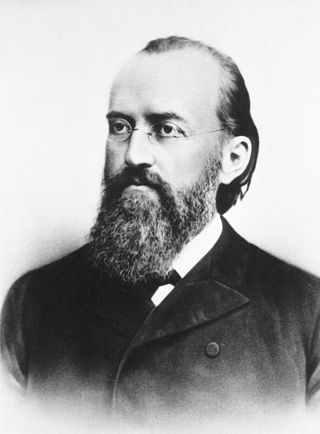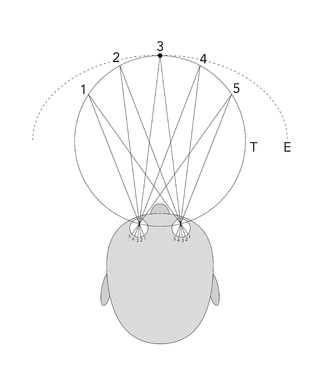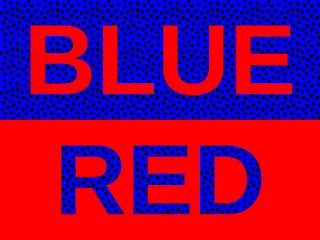
Karl Ewald Konstantin Hering was a German physiologist who did much research in color vision, binocular perception, eye movements, and hyperacuity. He proposed opponent color theory in 1892.

In biology, binocular vision is a type of vision in which an animal has two eyes capable of facing the same direction to perceive a single three-dimensional image of its surroundings. Binocular vision does not typically refer to vision where an animal has eyes on opposite sides of its head and shares no field of view between them, like in some animals.

Stereoscopy is a technique for creating or enhancing the illusion of depth in an image by means of stereopsis for binocular vision. The word stereoscopy derives from Greek στερεός (stereos) 'firm, solid', and σκοπέω (skopeō) 'to look, to see'. Any stereoscopic image is called a stereogram. Originally, stereogram referred to a pair of stereo images which could be viewed using a stereoscope.

Depth perception is the ability to perceive distance to objects in the world using the visual system and visual perception. It is a major factor in perceiving the world in three dimensions. Depth perception happens primarily due to stereopsis and accommodation of the eye.

An autostereogram is a two-dimensional (2D) image that can create the optical illusion of a three-dimensional (3D) scene. Autostereograms use only one image to accomplish the effect while normal stereograms require two. The 3D scene in an autostereogram is often unrecognizable until it is viewed properly, unlike typical stereograms. Viewing any kind of stereogram properly may cause the viewer to experience vergence-accommodation conflict.

Binocular rivalry is a phenomenon of visual perception in which perception alternates between different images presented to each eye.
A random-dot stereogram (RDS) is stereo pair of images of random dots that, when viewed with the aid of a stereoscope, or with the eyes focused on a point in front of or behind the images, produces a sensation of depth due to stereopsis, with objects appearing to be in front of or behind the display level.
Stereopsis is the component of depth perception retrieved by means of binocular disparity through binocular vision. It is not the only contributor to depth perception, but it is a major one. Binocular vision occurs because each eye receives a different image due to their slightly different positions in one's head. These positional differences are referred to as "horizontal disparities" or, more generally, "binocular disparities". Disparities are processed in the visual cortex of the brain to yield depth perception. While binocular disparities are naturally present when viewing a real three-dimensional scene with two eyes, they can also be simulated by artificially presenting two different images separately to each eye using a method called stereoscopy. The perception of depth in such cases is also referred to as "stereoscopic depth".

The horopter was originally defined in geometric terms as the locus of points in space that make the same angle at each eye with the fixation point, although more recently in studies of binocular vision it is taken to be the locus of points in space that have the same disparity as fixation. This can be defined theoretically as the points in space that project on corresponding points in the two retinas, that is, on anatomically identical points. The horopter can be measured empirically in which it is defined using some criterion.

Eye movement includes the voluntary or involuntary movement of the eyes. Eye movements are used by a number of organisms to fixate, inspect and track visual objects of interests. A special type of eye movement, rapid eye movement, occurs during REM sleep.

Fixation disparity is a tendency of the eyes to drift in the direction of the heterophoria. While the heterophoria refers to a fusion-free vergence state, the fixation disparity refers to a small misalignment of the visual axes when both eyes are open in an observer with normal fusion and binocular vision. The misalignment may be vertical, horizontal or both. The misalignment is much smaller than that of strabismus. While strabismus prevents binocular vision, fixation disparity keeps binocular vision, however it may reduce a patient's level of stereopsis. A patient may or may not have fixation disparity and a patient may have a different fixation disparity at distance than near. Observers with a fixation disparity are more likely to report eye strain in demanding visual tasks; therefore, tests of fixation disparity belong to the diagnostic tools used by eye care professionals: remediation includes vision therapy, prism eye glasses, or visual ergonomics at the workplace.
Monocular vision is vision using only one eye. It is seen in two distinct categories: either a species moves its eyes independently, or a species typically uses two eyes for vision, but is unable to use one due to circumstances such as injury.
Binocular disparity refers to the difference in image location of an object seen by the left and right eyes, resulting from the eyes' horizontal separation (parallax). The mind uses binocular disparity to extract depth information from the two-dimensional retinal images in stereopsis. In computer vision, binocular disparity refers to the difference in coordinates of similar features within two stereo images.

The Spinning Dancer, also known as the Silhouette Illusion, is a kinetic, bistable, animated optical illusion originally distributed as a GIF animation showing a silhouette of a pirouetting female dancer. The illusion, created in 2003 by Japanese web designer Nobuyuki Kayahara, involves the apparent direction of motion of the figure. Some observers initially see the figure as spinning clockwise and some counterclockwise. Additionally, some may see the figure suddenly spin in the opposite direction.

Chromostereopsis is a visual illusion whereby the impression of depth is conveyed in two-dimensional color images, usually of red–blue or red–green colors, but can also be perceived with red–grey or blue–grey images. Such illusions have been reported for over a century and have generally been attributed to some form of chromatic aberration.
In human visual perception, the visual angle, denoted θ, subtended by a viewed object sometimes looks larger or smaller than its actual value. One approach to this phenomenon posits a subjective correlate to the visual angle: the perceived visual angle or perceived angular size. An optical illusion where the physical and subjective angles differ is then called a visual angle illusion or angular size illusion.
Stereoscopic depth rendition specifies how the depth of a three-dimensional object is encoded in a stereoscopic reconstruction. It needs attention to ensure a realistic depiction of the three-dimensionality of viewed scenes and is a specific instance of the more general task of 3D rendering of objects in two-dimensional displays.

Hans Wallach was a German-American experimental psychologist whose research focused on perception and learning. Although he was trained in the Gestalt psychology tradition, much of his later work explored the adaptability of perceptual systems based on the perceiver's experience, whereas most Gestalt theorists emphasized inherent qualities of stimuli and downplayed the role of experience. Wallach's studies of achromatic surface color laid the groundwork for subsequent theories of lightness constancy, and his work on sound localization elucidated the perceptual processing that underlies stereophonic sound. He was a member of the National Academy of Sciences, a Guggenheim Fellow, and recipient of the Howard Crosby Warren Medal of the Society of Experimental Psychologists.
Stereoscopic motion, as introduced by Béla Julesz in his book Foundations of Cyclopean Perception of 1971, is a translational motion of figure boundaries defined by changes in binocular disparity over time in a real-life 3D scene, a 3D film or other stereoscopic scene. This translational motion gives rise to a mental representation of three dimensional motion created in the brain on the basis of the binocular motion stimuli. Whereas the motion stimuli as presented to the eyes have a different direction for each eye, the stereoscopic motion is perceived as yet another direction on the basis of the views of both eyes taken together. Stereoscopic motion, as it is perceived by the brain, is also referred to as cyclopean motion, and the processing of visual input that takes place in the visual system relating to stereoscopic motion is called stereoscopic motion processing.

The Hering–Hillebrand deviation describes the mismatch between the theoretical and empirical horopter. The horopter is the set of points that projects at the same location in the two retinae. Geometrically the horopter is a circle passing through the nodal point of the two eyes and through the fixation point. This is known as the horizontal geometrical horopter, or as the Vieth–Müller circle. This is the set of points that correspond geometrically to the intersection between visual lines at identical eccentricities. There is also a vertical horopter which is a straight line on the sagittal plane and passing through the intersection between the sagittal plane and the Vieth–Müller circle.














